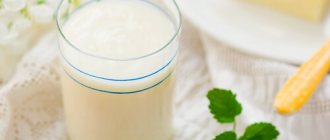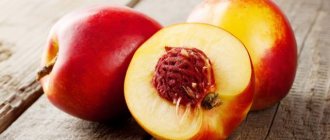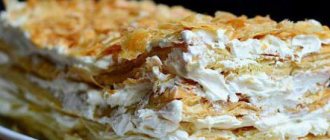Dietary properties:
What is the calorie content of a peach, what dietary properties does it have? All this is of great interest to those who lead a healthy lifestyle and watch their figure. So we will try to answer these questions in the next article.
So:
Peach has a very useful composition. It contains organic acids, such as malic, citric, tartaric; chemical elements - potassium, iron, phosphorus, manganese, copper, zinc, selenium, magnesium. Among the beneficial components of these fruits, vitamins should be noted: C, vitamins B, E, K, PP, provitamin A (carotene). In addition, they contain pectins and essential oils. Peach seeds can be of great benefit, since they contain bitter almond oil and vitamin B17 (aka laetral).
Peach composition:
Vitamins:
| Vitamin: | WITH | IN 1 | AT 2 | AT 4 | AT 5 | AT 6 | RR | E |
| in mg. per 100 grams | 10.0 | 0.04 | 0.08 | 6.1 | 0.15 | 0.06 | 0.8 | 1.1 |
Minerals:
| Mineral: | Calcium | Phosphorus | Magnesium | Potassium |
| in mg. per 100 grams | 20 | 34 | 18 | 363 |
It cannot be said that it is a very valuable food product for humans. Of course, the pulp of these fruits is very juicy and nutritious, with a pleasant aroma, and is also easily digestible.
Peach is considered a gourmet product. It is recommended for use by children, as well as people recovering from illness, to improve appetite. Peaches should definitely be included in the diet for constipation and heartburn. They promote the secretion of gastric juice and help digest fatty foods. They will be useful for such ailments as gout, rheumatism, kidney and cardiovascular diseases, liver and gall bladder diseases.
Despite all the beneficial properties that this fruit has, there are few calories in it. Therefore, peaches are a wonderful part of any diet. Nutritionists say that it will be enough to eat a few (3 - 4 pieces) peaches a day, and your body weight will begin to decrease. At the same time, the body will receive various beneficial substances and vitamins.
The benefits and harms of peaches
Despite the low calorie content of peaches, they are not recommended for those with medical conditions such as obesity or diabetes. Peaches are not recommended for those who are allergic to this product, as well as for people prone to rapid mental reactions and having an easily excitable nervous system - after all, peaches excite the nervous system and stimulate its functioning.
Now peaches are the favorite fruit of the inhabitants of America, Europe and Asia. And it's not just about their taste and aroma. These are foods high in antioxidants.
They have anti-inflammatory and antifungal properties, protect against the development of diseases and improve metabolism. Oil is prepared from them, which is used in medicine and cosmetology.
The benefits and harms of peaches are being studied by domestic and foreign scientists, and research confirms the beneficial properties of the fruit.
The fruit contains vitamins, minerals, antioxidants and phytonutrients. The high nutrient content determines the benefits and harms of peaches. The calorie content of fruits is low - 39 kcal per 100 g. They contain:
- Vitamin A (11% of the recommended daily value).
- Vitamin C (11%).
- Copper (7.5%).
- Tocopherol (5%).
- Fiber (4%).
- Potassium (4%).
- Iron (3%);
- Manganese (3%).
- Vitamin B5 (3%).
- Phosphorus (2%).
- Vitamin K (2%).
The product also contains carotene, lutein and zeaxanthin, cryptoxanthin, organic acids, calcium, B vitamins, fluorine, etc.
Juicy, velvety fruits native to China have long been grown not only in this region of Asia, but throughout the world. They are famous for their tender, melting flesh, sweet taste and amazing aroma.
At the same time, as peaches ripen, in addition to sugars, they accumulate a lot of useful substances, becoming a valuable dietary product.
What are the benefits of peach? What minerals and vitamins does the body receive if you regularly include these fruits in your diet?
This combination attracts both delicacy-hunting wasps and gourmets of all ages. Just 100 grams of fruit contains:
- about 1 gram of protein;
- negligible amount of fat;
- 9.5 grams of carbohydrates;
- 0.5–1 grams of organic acids;
- 2.1 grams fiber;
- 0.6 grams of ash;
- 86 grams moisture.
The calorie content of peaches per 100 grams is only 45 kcal. The fruits contain ascorbic acid and beta carotene, B vitamins and biotin, niacin, vitamins E and PP.
Among the macroelements that this type of stone fruit is rich in are phosphorus and sodium, potassium and calcium, magnesium, sulfur and silicon. The list of microelements includes iron and zinc, copper and aluminum, iodine and fluorine.
Such a wide range of bioactive compounds determines the benefits of peaches and harm, which cannot be excluded if consumed carelessly.
Due to the content of potassium, magnesium and a lot of vitamins, the pulp of ripe fruits will help strengthen the heart, large vessels and capillaries. Moderate consumption of peaches warns:
- blood clot formation;
- accumulation of harmful cholesterol and its deposition on the walls of blood vessels;
- diseases associated with heart rhythm disturbances.
The dietary fiber contained in the pulp of peaches, as well as the skin covered with velvety fluff, stimulates digestive processes. Contrary to common misconceptions, villi cannot cause intestinal upset. Subject to compliance with safety standards, fruits:
- support healthy peristalsis;
- promote food digestion;
- improve nutrient absorption;
- help the timely removal of waste and toxins.
The cleansing properties of peaches extend beyond the gastrointestinal tract. The fruits have a pronounced choleretic and diuretic effect. A fresh dessert made from sunny fruits will help eliminate puffiness, remove excess fluid and naturally maintain blood pressure levels.
Organic acids, calcium and phosphorus serve to strengthen bones, accelerate regeneration and improve their structure. The same applies to tissue health and rejuvenation.
In small quantities, but regularly, the fruits are recommended for arthritis, osteochondrosis, osteoporosis and signs of rheumatism. In this case, the strengthening effect is combined with a cleansing effect. Thanks to fruits, salts, excess moisture and toxins leave the body without delay.
Fruit acids, minerals and vitamins of peaches have a beneficial effect not only on the condition of tissues and internal organs. External use gives the skin:
- active mitigation;
- hydration;
- cleansing of excess skin secretions, fat and dust;
- nutrition.
The almost complete absence of harm and benefits of peaches for the most delicate skin have long been appreciated by cosmetologists. Acting comprehensively, for example, as part of a mask, the juicy pulp gradually relieves inflammation, smooths out wrinkles, brightens and evens out the complexion.
Peaches are an excellent source of vitamins, mineral acids and other substances that a person needs for well-being, vigor and health. Among other things, sweet summer fruits:
- strengthen the immune system, helping to resist stress and seasonal colds;
- accelerate recovery and recovery from illness;
- increase performance and memory;
- work as antioxidants, allowing you to prolong youth.
If peaches are intended for a woman expecting a baby, you need to make sure that the fruits do not cause an allergic reaction. Can you eat peaches while breastfeeding? As during pregnancy, the inclusion of southern fruits in the diet should be treated with caution, especially if this product was not previously part of the usual diet.
Two or three fruits a day will not cause harm, and the benefits of peaches will be expressed in relieving the symptoms of morning sickness. Juicy, ruddy fruits will help maintain hemoglobin levels, prevent vitamin deficiency and improve your mood.
Despite the abundance of beneficial properties, peach can be harmful to health. This happens with careless and immoderate use. The high concentration of sugar makes the fruit not very desirable for diabetics. People prone to allergies should also treat fruits with care.
We invite you to familiarize yourself with: Multi-colored trees in autumn
The risk category includes patients with gastritis with high acidity, a tendency to diarrhea, or those suffering from dyspepsia. Excessive infatuation with velvety fruits can cause upset and deterioration of the condition during exacerbation of chronic ailments of the digestive tract.
Renaissance artists considered it an elixir of love, and Russian poets associated the fruit with the tenderness of girls.
Its name translates as “Persian plum”. However, the fruit came to Persia centuries later.
Before that, it was grown only in the Middle Kingdom. Even later (in the 1st century AD) it came to Europe, and then spread throughout the world.
Peaches of commercial interest are divided into 4 classes:
- peches – a real or ordinary peach with pubescent fruits and an easily separated pit;
- pavies - velvety fruit with pulp that does not separate from the stone;
- nectarine - a hairless fruit with pulp separating from the seed;
- brugnons, violettes - nectarines with pulp that does not separate from the seed.
The flat fruits are commonly called fig peaches. They are not actually related to figs. This is one of the varieties of the common peach.
The claim that nectarine is a hybrid of peach and some other fruit (usually called plum) is also a myth. Its appearance is associated with mutation, but not with hybridization.
Moreover, this happened quite a long time ago, when the crop began to self-pollinate. A man liked this mistake of nature and began to develop it by breeding nectarines.
The unique aroma and juicy sweet pulp are what people love about peaches. The health benefits and harms of this product are determined by its composition.
Chemical composition
About 85% of the fruit pulp is water. But fruits are also distinguished by their rich mineral and vitamin composition, and the presence of large amounts of fiber necessary for digestion.
Nutrition scientists continue to actively study the chemical composition of the pulp. The purpose of this activity is to learn more about how peach is useful for the body, and who should avoid eating it.
The pulp contains:
- acids (tartaric, malic, citric, quinic);
- mono- and disaccharides;
- minerals (magnesium salts, potassium salts, iron, zinc, phosphorus, copper, selenium);
- vitamins, essential oils, pectins, fiber.
The seed contains a large amount of fat - up to 45%.
- C (ascorbic acid) – 10 mg.
- B1 – 0.04 mg.
- B2 – 0.08 mg.
- PP (niacin) – 0.8 mg.
- B2 (folic acid), vitamins K, E, carotenoids.
The calorie content of fresh peaches depends on the variety and ranges from 44.5 to 50.84 kcal. One pitted fruit weighs 85–100 g. Based on this, you can easily find out how many calories are in a medium-sized peach.
The energy value of one fruit is 38.2–50 kcal. The calorie content of fig peaches is within the same range. Since the chemical composition of the fruit is identical.
BZHU peach
BJU ratio – 11.4%, 3.1%, 85.5%. A significant amount of carbohydrates should not scare those who are used to counting calories. After all, most of the fruit is water.
Glycemic index (GI) of the product is 30–35 units. For canned fruits this figure is 3 times higher.
Few people think about the benefits of peach for the body. And completely in vain. Product contains:
- potassium and magnesium are elements involved in the regulation of vascular tone;
- plant pigments (bioflavonoids and carotenoids) that fight free radicals, helping people avoid cancer;
- vitamins that facilitate the absorption of iron into the blood.
The beneficial properties of peach and contraindications largely depend on the quality of the product. Indeed, in addition to the listed components, the pulp may also contain harmful substances, for example, nitrates.
Fresh fruits in the diet have a positive effect on the digestive, cardiovascular systems, gastrointestinal tract, kidneys, and liver. Doctors recommend including this product in your diet if you are prone to constipation and heartburn.
Moderate consumption of peaches:
- improves the condition of the small intestinal mucosa;
- normalizes the state of the nervous system;
- helps regulate vascular pressure;
- improves well-being with gout and rheumatism;
- acts as a mild diuretic;
- strengthens the immune system.
Contraindications
However, not everyone benefits from these juicy fruits with edges. Their use should be avoided if:
- individual intolerance;
- increased acidity of gastric juice;
- diabetes mellitus;
- chronic diarrhea.
How many calories are in a peach?
Here's how much:
The calorie content of a fresh peach, per 100 grams, is 46 kcal.
Which is very little for fruit.
Proteins, fats and carbohydrates (BJU) in gr. per 100 grams:
Proteins - 0.9
Fats – 0.1
Carbohydrates – 11.3
A:
The calorie content of fig peach per 100 grams is 60 kcal.
Proteins, fats and carbohydrates (BJU) in gr. per 100 grams:
Proteins - 0.9
Fats – 0.1
Carbohydrates – 14.0
Naturally, the calorie content of a peach depends on the cooking method.
Pay attention to this table:
Table of peach calorie content and nutritional value (BJU) per 100 grams:
| Peach: | Bel, gr. | Fat, gr. | Angle, gr. | Cal, kcal. |
| Dried | 3.0 | 0.4 | 57.7 | 254 |
| Juice | 0.9 | 0.1 | 9.5 | 40 |
| Nectar | 0.2 | 0.0 | 9.0 | 38 |
| Compote | 0.5 | 0.0 | 19.9 | 78 |
Are peaches good for weight loss?
And more on this topic:
It’s not for nothing that nutritionists consider peach an ideal product for weight loss, because in addition to being a low-calorie fruit, it also has a number of beneficial properties. Peach contains many minerals, vitamins and organic acids valuable for humans.
There is also a general peach diet, the meaning of which is to replace a standard dinner with several peaches and maintain proper nutrition. Since the calorie content of peach is low, it contains many vitamins and nutrients, including fiber. When applying this diet, you need to give up sweets and fried foods, reduce the amount of salt to one pinch per day. There is no point in talking about mayonnaise and all kinds of ketchups - it’s taboo. You can drink pure water, tea, compote, freshly squeezed juice. Forget about sweet soda and alcohol, not only is it harmful, it is also very high in calories.
Application
Fresh peach juice is drunk pure or in combination with other juices. It is often used to make a delicate sauce for ice cream and desserts.
Cosmetologists value peach juice and make a variety of masks and lotions based on it.
Market Analytics
- COVID-19 is changing the rules of the game in the cosmetics market
- Beauty of the future: cosmetic innovations 2020
- New ingredients are the driving force of the cosmetics industry
Convenient search for beauty salons on our website
Beauty salons in Moscow Beauty salons in St. Petersburg Beauty salons in Ekaterinburg Beauty salons in Novosibirsk
Latest blog posts on our website
- Naturecream / Geranium (Pelargonium) oil for skin health and beauty
- Prostye-sovety / Save on a beauty salon: procedures that can be done at home
- Naturecream / Growth Factor - brings back youth?
- Oksana-Lezina / 3 effective abdominal exercises from a fitness instructor for beginners
- Prostye-sovety / Making perfect curls at home
- Prostye-sovety / Which hair removal method to choose
- Naturecream / Wrinkles Puppets
- Naturecream / PEPHA-TIGHT - instant skin lifting
- Naturecream / Blue light - a danger to the skin
- Naturecream / Cocoa Butter – A treat for the skin
Latest forum topics on our website
- Mrs._Smith / Badly sunburned! What to do?((
- Ice / Is it necessary to combine fitness classes with a diet?
- Antonova / What can be used for hair loss?
- Radio operatorKat / Who was on a protein diet?
- Suzanna / Mesotherapy on the face
Other articles in this section
| Cocoa mass Cocoa mass is ground cocoa beans (cocoa nibs), which have previously undergone fermentation, drying and roasting. During the grinding process, cocoa beans begin to melt under the influence of temperature and form cocoa butter. An indicator of the efficiency of grinding cocoa beans is the viscosity value. The smaller it is, the more fully the cocoa butter is isolated and the easier it is to further use the grated cocoa. The rainforests of South America are traditionally considered to be the birthplace of cocoa. |
| Elderberry juice Black elderberry is a medicinal plant that has many vitamins and microelements, which make it a universal remedy in the fight against colds, decreased immunity, loss of strength, anemia and even hepatitis C. |
| Dry masala tea Masala is known as spiced tea. It is of Indian origin and is obtained by brewing various herbs and spices with the addition of milk, sugar and other ingredients. Very diverse in ingredients and brewing methods. |
| Rose hip juice Rose hip juice is made from rose hips. This plant was the first species that people began to breed in ancient times. Initially because of its beauty, but later as a useful medicinal plant for many diseases. |
| Kissel from dried apricots Kissel is a traditional Russian dish, the recipe of which dates back many centuries. Its benefits are known to many people who have not only heard about it, but also tried it. Over time, the recipe for making jelly was noticeably improved, and more and more new ingredients were added to its composition. It should be noted that until recently starch was not used in the preparation of this dish and fermented decoctions of cereals served as the basis. |
| Coffee with condensed milk There are more than 90 types of coffee. The main ones, which have a pronounced taste and therefore value, are named after the trees from which the harvest is harvested: Robusta, Liberica and Arabica. These coffee varieties are mainly produced in Oceania, Africa, Asia. By mixing grains of these varieties in different proportions and with different degrees of roasting, blends are created, the recipe of which is the manufacturer’s proprietary recipe. You can prepare coffee using different recipes; one of the attractive options is coffee with condensed milk. |
| Cola Cola is a non-alcoholic, carbonated drink that gets its name from small cola nuts that are a source of caffeine. In different countries, various drinks are made based on the cola recipe, such as Pepsi-Cola, Afri-Cola. |
| Carrot juice The famous carrot juice is considered a leader among other natural drinks in terms of its versatility and breadth of effects on the entire human body. This juice is deservedly considered the king among all other vegetable juices, as it contains many vitamins and various chemical beneficial elements. The unique healing and nutritional properties of this juice have been noticed for a long time; since ancient times it has been used in the treatment of a number of diseases. |
| Water Water (otherwise hydrogen oxide, chemical formula H2O) - under normal conditions it is a transparent liquid that in a small volume has no taste, smell or color. Water, depending on conditions, can acquire three states: liquid, solid and gaseous. |
| Noni Juice The sap of the Noni tree is produced in Thailand and is considered a healing drink. It helps with serious illnesses when used correctly. It has a light cinnamon color, pleasant taste and unusual aroma. When making juice, no dyes or flavors are used, only natural fruit puree of this fruit. |









